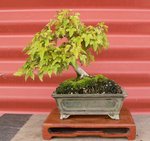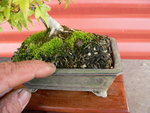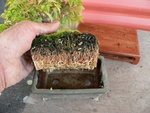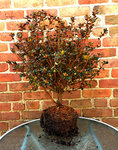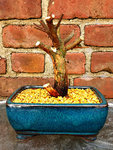Lazylightningny
Masterpiece
This thread will be about repotting. When do you repot? Why do you repot at that time? Do you repot at other times of the year also? Why? What's the reasoning behind your technique and aftercare? Show us some pictures of your repotting with some explanations. I hope this will be a thread that beginners and experts alike can get something out of. You don't necessarily HAVE to post a picture with your comment.
Here is an American elm volunteer that popped up in my yard 5 years ago and has been in the ground thickening ever since. It was chopped once last year and again earlier this year. It has attained some decent thickness, and buds were lengthening, so I decided to lift it, bare root, and pot up. It had a lot of thick, down-growing roots, which I removed. A good nebari comes from lateral roots, not down-growing roots. In this particular case, I potted in the spring, as buds were lengthening but before they opened. That way, the plant expends as much of its stored energy toward the buds as it can before I drastically reduced the roots. This will delay the opening of the leaves, but if you wait until the leaves open, I've found that the tree can't support the new leaves after roots have been drastically reduced. It was wired into this plastic training pot in a mixture of equal parts of sorted and sifted lava, pumice, and akadama. It was placed back in the sun (or what there is of it lately) and watered once every day. This is my typical aftercare, unless I do a summer repot and the temps are over 90 degrees F.
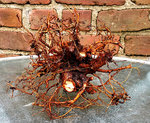
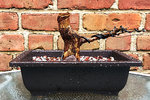
Here is an American elm volunteer that popped up in my yard 5 years ago and has been in the ground thickening ever since. It was chopped once last year and again earlier this year. It has attained some decent thickness, and buds were lengthening, so I decided to lift it, bare root, and pot up. It had a lot of thick, down-growing roots, which I removed. A good nebari comes from lateral roots, not down-growing roots. In this particular case, I potted in the spring, as buds were lengthening but before they opened. That way, the plant expends as much of its stored energy toward the buds as it can before I drastically reduced the roots. This will delay the opening of the leaves, but if you wait until the leaves open, I've found that the tree can't support the new leaves after roots have been drastically reduced. It was wired into this plastic training pot in a mixture of equal parts of sorted and sifted lava, pumice, and akadama. It was placed back in the sun (or what there is of it lately) and watered once every day. This is my typical aftercare, unless I do a summer repot and the temps are over 90 degrees F.



